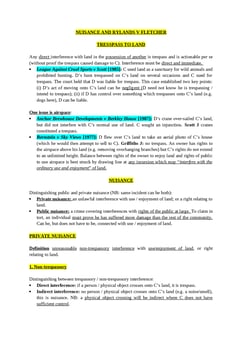Heneghan v Manchester Dry Docks [2016] EWCA Civ 86
Judgement for the case Heneghan v Manchester Dry Docks
Table Of Contents
KEY POINTS
-
The elements required to apply the principle identified in Fairchild are present in this case:
All the defendants acknowledge their breach of duty;
Each defendant contributed to increasing the risk of the deceased developing lung cancer;
All exposed the deceased to the same causative agent (asbestos fibres); however,
Medical science cannot determine which defendant's exposure specifically caused the cell changes leading to the genetic alterations that resulted in the cancer.
FACTS
This case revolves around the death of Mr. James Heneghan due to lung cancer caused by asbestos exposure. He was exposed to asbestos while employed successively by six defendants. While it is difficult to pinpoint which specific exposure led to his cancer, epidemiological evidence shows how each defendant's exposure contributed to increasing the risk of contracting the disease.
-
Mr. Heneghan was born in 1938 and was exposed to asbestos fibres and dust during his working life. He was diagnosed with lung cancer in 2012 and passed away in 2013.
The parties agreed on the quantified exposure to asbestos over his working life, and it was determined that the six defendants were responsible for 35.2% of the total exposure.
The doses of exposure ranged from 2.5% to 10.1%, with a cumulative exposure of 25 fibres/ml years being sufficient to link lung cancer to asbestos exposure, given a ten-year interval between first exposure and cancer onset.
The parties also agreed to proceed on the basis of a more than five-fold increase in the risk of lung cancer attributable to Mr. Heneghan's cumulative asbestos exposure over his employments, considering the amphibole fibres in his exposure.
COMMENTARY
This case highlights the complexities that can arise in causation issues, especially in cases involving multiple exposures and diseases with long latency periods.
The Fairchild exception provides a practical solution to ensure that claimants can still recover damages in situations where it is impossible to identify the precise cause of harm.
RELATED CASES
For Further Study on Heneghan v Manchester Dry Docks
Need instant answers? Our AI exam tutor is here to help.
Ask questions 🙋 Get answers 📔 It's simple 👁️👄👁️
Our AI is educated by the highest scoring students across all subjects and schools. Join hundreds of your peers today.
Get StartedSimilar Cases
Related Product Samples
These product samples contain the same concepts we cover in this case.
| Tort Law | Causation And Remoteness Notes (22 pages) |
| Tort Law | Ministry Of Defence V Ab And Others Notes (3 pages) |

